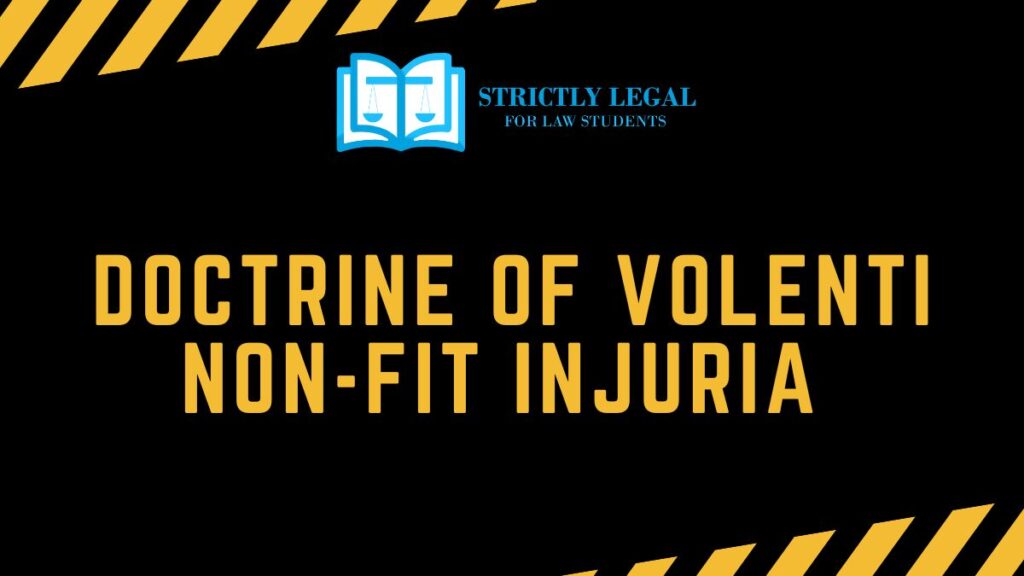Torts is a civil wrong. In the law of torts, if any person commits any wrongful act which causes injury to another person, he is held accountable and has to pay damages or provide some other remedy other than damages that the court determines to the victim of such an act. But in rare cases, if a person suffers from some loss or injury because of someone else, that person still cannot claim for compensation from the other person because of the operation of defense of tort. One of such defenses available to the defendant is the doctrine of Volenti Non-fit Injuria where the plaintiff is not entitled to recover damages because he had given his consent to the act that caused him injury.
Table of Contents
What exactly is Volenti Non-fit Injuria ?
In the law of torts, there is a duty on every person to act with reasonable care in order to avoid any harm which may occur for their failure of taking good care. This is the general rule in torts but like every other statute, there are certain exceptions to this also which are known as defenses of torts. Under such defenses, the defendant can get away from liability and Volenti Non-fit Injuria is also one such defense which is obtainable for the defendant. In case a person consents to perform an act that leads to him getting injured, then even if an injury is caused by another person, he cannot claim for compensation from that person as the performance was the one for which he gave his consent voluntarily. The consent of the plaintiff here acts as a defense and this defense is termed as Volenti Non-fit Injuria which portrays that no injury can happen to a willing person.
A simple illustration of this can be if a person A is driving his car, he has to drive the car safely and within the limits of the speed as that is his duty as a driver so that no harm is caused to any other person and no accident occurs.
Elements of Volenti Non-fit Injuria
For the implementation of the defense of Volenti Non-fit Injuria there consists of some essential elements or conditions which have to be present in a case and only when they are fulfilled, this defense can be taken as to prevent liability.
There are two elements in this defence:
- The plaintiff being well versed with the risks
- The plaintiff being well versed with the risks has agreed to suffer the harm voluntarily.
Hence, whenever the plaintiff is well aware of the possibility of harm that is likely to be caused by an act and when he still chooses to accept to perform that act and hence agrees to suffer the injury or harm, a defendant is then eased from his accountability.
Elements of Volenti Non-fit Injuria
For the implementation of the defense of Volenti Non-fit Injuria there consists of some essential elements or conditions which have to be present in a case and only when they are fulfilled, this defense can be taken as to prevent liability.
There are two elements in this defence:
- The plaintiff being well versed with the risks
- The plaintiff being well versed with the risks has agreed to suffer the harm voluntarily.
Hence, whenever the plaintiff is well aware of the possibility of harm that is likely to be caused by an act and when he still chooses to accept to perform that act and hence agrees to suffer the injury or harm, a defendant is then eased from his accountability.
However, just having knowledge about the risk is not ample enough to be implemented as a defense. This scenario is known as Scientific non-fit Injuria which says that mere knowledge does implicate that it has been consented to risk. Hence, having knowledge is just a partial fulfilment of the conditions or the application of volenti non-fit injuria.
In the case of Smith v. Baker & Sons, the plaintiff was an employee of the defendant and the worksite where Smith used to work had cranes which used to carry rocks over the heads of the employees. The plaintiff had also complained to the respondent regarding the same. One fine day the plaintiff was injured by the rocks falling on him and further he prosecuted the defendant for the damage that occurred. It was held that the defendant was accountable and had to pay compensation to the plaintiff as the plaintiff had given his consent to the risk of the job expectations but NOT to the lack of reasonable care.
Burden of Proof
In cases where the defendant is opting for the defense of Volenti Non-fit Injuria, the burden of proof is upon the defendant to prove that the plaintiff had complete knowledge of the act and he had given his consent to the risk involved in the act and also that the plaintiff was well versed and well aware for the extension of risk that was involved in the act for implementing the defense successfully.
Consent of the Plaintiff
The consent of the plaintiff is one of the important essentials for proving the doctrine of Volenti Non-fit Injuria because the doctrine can only be implemented as a defense when the plaintiff has voluntarily consented to an act, then only the defendant can use this as a defense.
Consent may be either be expressly given or can also be shown by his conduct, which should be free from coercion, fraud or any other such means by which the free consent can be affected.
Limitations to the application of Volenti Non-fit Injuria
There are a few limitations under which the defense of volenti non-fit injuria cannot be used as a defense by the defendant irrespective of the essentials being present in the case.
Rescue Cases
When the plaintiff suffers an injury for him performing an act that he knows is likely to cause him harm but it is an act to rescue someone, then this defence will not be applicable and the defendant will be held accountable.
Illegal Acts
If the consent is expressed or implied for an act which is not allowed by law then, even on the completion of all the essential conditions of the defense, the liability cannot be escaped and thus in such cases, this defense becomes unserviceable.
Negligence of the Defendant
The defense of Volenti Non-fit Injuria is not applicable in cases where the defendant has been negligent. Hence, where there is no negligence by the defendant he can allege this defence to escape accountability.
Conclusion
Volenti Non-fit Injuria is one of such defenses under the Law of Torts where the person who has committed the wrong is free from liability as the victim of such wrong consent o the commission of such an act and such a consent must be free for the successful implementation of the defense in the case.

Law student.
Turning legal insights into engaging narratives.




